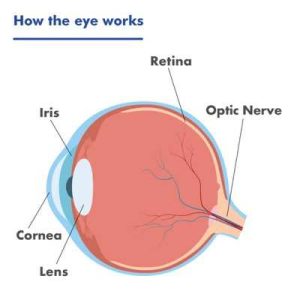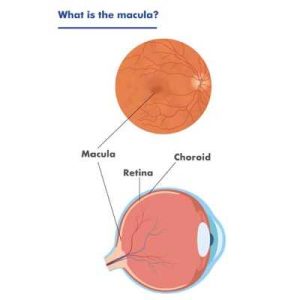Macula Awareness Month
 More than 1.9 million Australians have signs of macular disease, but many may not know it.
More than 1.9 million Australians have signs of macular disease, but many may not know it.
This May, Macular Disease Foundation Australia’s annual awareness campaign aims to help Australians understand their risk of macular diseases. When you understand your risk and know what to do, you can take early action that could save your sight.
Macular disease covers a range of painless conditions affecting the central retina (the macula), which is at the back of the eye. It is the leading cause of blindness and severe vision loss in Australia.
So, what is the macula?
Your eye is very much like an old-style film camera. The front of your eye is made up of the cornea, iris, pupil, and lens. These work together to focus an image onto the retina, which lines the back of your eye.
The retina is a light-sensitive tissue that acts like the film in a camera. It captures images and sends them to the brain via the optic nerve. Our brain then interprets the image for us.
The macula is the name given to the area at the centre of the retina at the back of your eye. This region is only about 5.5mm in diameter.
The macula is responsible for detailed central vision. That means you use it for activities such as reading, driving, and recognising faces. It’s also responsible for most of your colour vision.
The rest of the retina is called the peripheral retina. Peripheral vision (or side vision) isn’t as clear as central vision. It’s used to see general shapes and surroundings.
 What are the symptoms of macular disease?
What are the symptoms of macular disease?
Conditions only affecting the macula don’t lead to total (‘black’) blindness. Instead, they impact central vision, leaving peripheral vision intact.
You can have early signs of macular disease without knowing it. However, when symptoms do appear, they can include:
- difficulty with reading or any other activity which requires detailed central vision (despite wearing appropriate glasses)
- distortion, where straight lines may appear wavy or bent
- problems distinguishing faces
- dark patches in the central vision.
If you notice any of these symptoms you should consult an eye health professional. Early detection and prompt intervention are crucial to saving sight.
Macular diseases include age-related macular degeneration (AMD), and diabetic retinopathy (DR) and diabetic macular oedema (DMO).
The most common macular disease is age-related macular degeneration. Approximately one in seven Australians over the age of 50 have some evidence of AMD.
DR, including DMO, is a common complication of diabetes. It’s the leading cause of preventable blindness in working-aged Australians. Everyone with diabetes is at risk of developing DR. The longer someone has diabetes, the greater their chance of developing the condition.
A diagnosis of macular disease will not necessarily mean you will lose your vision. Some macular conditions can be treated. You may also be able to make diet and lifestyle changes to slow the progression of the disease. If you do experience vision loss it is possible to live happily and remain independent.
If you are diagnosed with macular disease it’s important not to make any quick decisions regarding employment, activities, plans or your lifestyle. Seek advice from your eye health professional and low vision agencies.
Macular Disease Foundation Australia has a quick 60 second quiz, Check My Macula at this link –
mdfoundation.com.au/check-my-macula/overview
It’s a hugely successful tool to educate people over 50 about their risks of macular disease. And, of course, to encourage them to have regular eye exams.
For further information and support about macular diseases head to mdfoundation.com.au
Source: mdfoundation.com.au
Article by: Sandy Brangan, Brangan Medical Business Consultants






